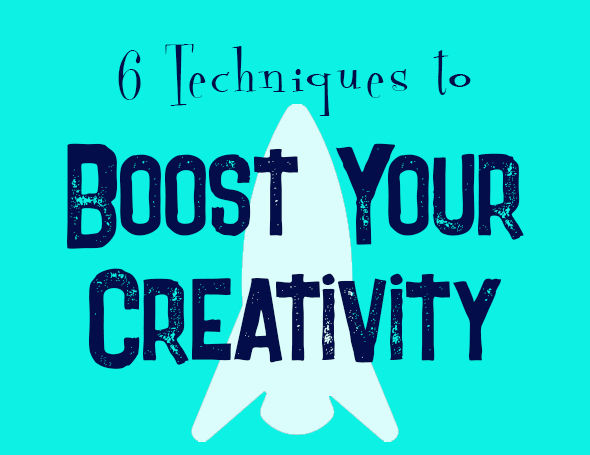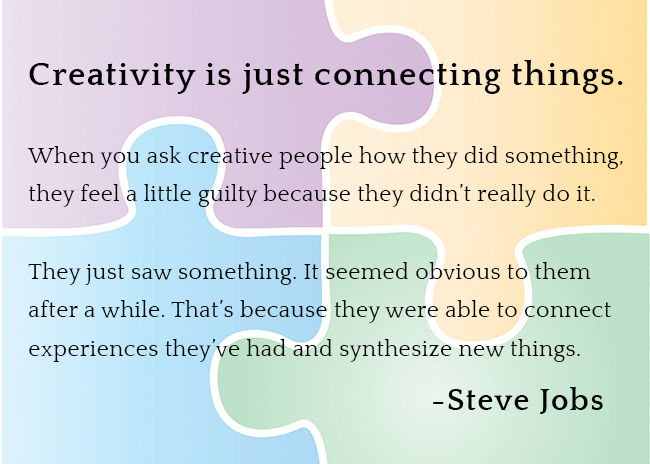
Guest post by Daisy Hartwell.
Creativity makes our world a better place.
Really, what would the world look like if no significant discoveries were made? No revolutionary ideas, or even just new approaches to doing things?
Creativity pushes humanity forward. It helps the gears of progress spin faster. And it simply makes people’s lives more exciting.
Find out what creativity really is, along with some great ways to spark it. We’ll describe six creativity techniques that you’ll be able to use while studying, working on a project, or just going about your everyday life.
Various disciplines have different ways of explaining creativity. These disciplines include education, psychology, linguistics, songwriting, and engineering, just to name a few. In general, however, they all cover the same basic relationships—like the link between creativity and intelligence, personality type, neurological and mental processes, mental health, and ability to create something new.
As a summary definition, we can say: Creativity is a phenomenon (an ability or a process) by which something different and new is made. This “something” can be either a physical object (painting, sculpture, invention, all sorts of creative things) or something intangible (a theory, joke, melody, idea).
Since the very concept of creativity first appeared, many theories, studies, and creativity articles have been published. They all suggest different explanations as to what the best methods, sources, and ways of developing creativity are. All based on the interpretation of different studies’ results.
It’s fair to say that the theories and studies themselves serve as great examples of the creative process.
Convergent and divergent thinking
This theory draws a connection between the creative process and different types of thinking. It’s mainly based on the distinction between convergent and divergent thinking. Convergent thinking means finding a single solution to a problem, whereas divergent thinking results in multiple creative solutions. Researchers point to the similarity between divergent thinking and creativity itself. Studies even prove that different thinking can lead to a better mood, which in turn improves the creative process.
Incubation
Incubation theory suggests another idea. It says that a short break from solving a problem or trying to come up with an idea aids creativity. The primary reason is that during the break, your brain forgets all the misleading thoughts and inappropriate strategies. Without these unnecessary ideas, the creative thinker can then come up with better and more relevant solutions. This theory is actually based on disputing earlier theories. These previous theories claimed that creative ideas appear in the unconscious mind while a person is focusing on other tasks.
Creative cognition approach
Creative cognition theory splits creativity into two stages: 1) generative, which consists of constructing mental representations, and 2) exploratory, which consists of coming up with innovative ideas based on those constructions. When using innovative thinking to develop new ideas, their structuring is usually based on already-existing concepts. However, there are also arguments that ordinary cognitive processes bring extraordinary results.
Everyday imaginative thought

There are also a few somewhat simplistic theories that have surprisingly gained a lot of popularity. One daily creative idea is based on counterfactual thinking. People can often imagine an alternative reality when thinking "if only…." These thoughts are considered to be the standard equivalent of creativity because generating such ideas involves similar cognitive processes.
Creativity techniques
We aren’t going to give you abstract ways to improve creativity—like "go for a walk," "listen to classical music," "find a creative place," and so on. The main reason is that all those things are very subjective. What works for one person won’t necessarily work for another. No one knows better than you what inspires you and makes you come up with ideas and solutions, so we’ll leave that for you to decide.Here’s what you’ll get instead. Here at Custom-Writing.org, we’ve decided to provide you with techniques that will show you how to improve creativity skills. You can see which one fits you best.
1. Improvisation
This process involves writing, speaking, and composing. Or performing any other sort of action without preparation or the use of a script. Improvisation usually opens up new ways of doing things. It helps with the discovery of original thought and practice patterns, new structures, and so on. It also improves the development of creative skills.

Improvisation is useful in science, art, or physical and cognitive activities. It has its place in both academic and non-academic disciplines. For instance, improvisation can be useful if you want to learn how to be more creative in writing. Let’s say, writing an essay. By enforcing various limits on you as a writer, you’ll have to write by stream of consciousness, without judgment of your work. This helps you overcome writer's block and enhance your writing instinct. It also improves flexibility in writing and acts as a creative booster in general.
2. Brainstorming
This is a creative thinking method that requires a group of people to work together and generate ideas. It follows the principle of suspending judgment.
Brainstorming can be used in any sphere imaginable, anywhere there’s a need to come up with new and fresh ideas. It’s helpful in marketing, writing a screenplay, or working on a project.

The process usually goes as follows:
Get together in a group.
Write down the initial topic for everyone to see. The more specifically you define the issue and state the problem, the better outcome you'll have.
Make sure that everyone understands the idea.
Set the rules. - Accept all ideas, without any criticism. - Aim for a significant number of ideas without limits. The more, the better. Otherwise, judgment will ensue. - Don’t break the flow, and avoid censoring ideas. - Save all discussion for later. Also, if possible, try to create ideas that are linked to previous ones. (This is not necessary but can be used as an option).
Have one person responsible for enforcing the rules. You should also have someone writing down the ideas (it can be the same person).
Start coming up with ideas. It can go two ways: 1) Everyone can share their views at any time, without structure, or 2) Ideas can be generated by taking turns around the table, with the option to pass.
Make final clarifications and conclusions. Group similar ideas and keep the rest as is. Decide what to do next based on the ideas you’ve gathered.
3. Lateral thinking

This technique involves problem-solving through a creative and indirect approach. It makes use of reasoning that might not be obvious at first. It also includes ideas that may fall outside the boundaries of conventional step-by-step logic.
One of the brightest examples of creative thinking of this kind is the Biblical story of the Judgment of Solomon. In that story, King Solomon solves the problem of parental custody by suggesting a child be cut in half. He then watches the reactions of each person and makes his judgment.
There’s a set of tools in lateral thinking that allows the person using them to reach specific goals. The technique itself finds use in many fields, including education, as it helps develop entirely new ideas that are "outside the box."
Disproving. Take any idea or concept that’s accepted or obvious. Then question it to make an opposite view in an attempt to discredit it.
Random entry idea generation. Choose an arbitrary object. Then try to associate it with the area or topic you’re interested in.
Challenge idea generation. The core of this method is asking “Why?” in a non-threatening way. It can be applied to pretty much anything, not only problems. The goal here is to introduce a challenge, which, in turn, brings a more precise understanding of the object. It also helps generate fresh ideas.
Provocation idea generation. The idea behind this tool is that you can create new ideas through provocative statements. These statements can be impossible or flat-out wrong to begin with. But the core aim is still coming up with ideas based on them.
4. Five W’s

This creative thinking technique is also known as the "Five W's and H." It can be used as a checklist when trying to solve a particular problem or come up with ideas.
This technique uses the following prompts in the form of questions:
Who?
Why?
What?
Where?
When?
How?
The method itself finds numerous formal and informal uses:
When in a discussion or meeting, this technique can serve as a quick checklist. It helps participants keep essential points in mind and come up with further questions.
It can generate questions to gather more data, especially when you’re at the early stage of solving a problem. It works well both as an informal and a systematic way to form a list of questions to answer.
It can be used as a part of another technique (such as brainstorming). This method can help generate questions that drive new ideas and thoughts.
It’s possible to use the method as an evaluation tool to form specific criteria.
5. False faces

This is one of the more straightforward creativity methods. It helps generate new ideas or find a solution to a problem.
Here’s how it goes:
Describe the problem.
Write down all assumptions connected with this problem.
Pick out the fundamental assumptions and challenge them.
Write completely opposing statements for each assumption you have.
Gather all differing points of view that may seem useful to you.
Think of how to turn all the conflicting statements you’ve written into reality. This will give you a set of new ideas and perspectives.
6. Simplex
This technique views the creative process as a continuous cycle. When one cycle is completed, it immediately leads to another period of improvement with the same steps. It can be easily adjusted to be used as a creative learning technique.
The Simplex technique consists of 8 stages:
Locating the problem. You can state the problem right away if it’s obvious. Otherwise, go through a series of questions to identify it.
Finding facts.This stage deals with finding as much information about your problem as possible. It’s also about evaluating the quality of that information, making assumptions, and checking their correctness.
Defining the problem. By now, you have an overall idea of what you're dealing with and enough information about it. So, make it more specific. State the exact problem you’re going to be dealing with. The more precise, the better. This will allow you to solve it more efficiently.
Finding ideas.This stage involves using other techniques to generate ideas (for instance, brainstorming or lateral thinking).
Selecting and evaluating.Once you’ve gathered enough ideas, it’s time to select the ones that will help you the most in solving your problem. You can develop criteria based on what you want to achieve or just gradually get rid of the least suitable ideas until you’re left with the most appropriate ones. Then evaluate the approach you’ve selected, and think of all the benefits you’ll get from it. You need to make sure that it’s good enough to solve the problem. If you’re still in doubt, it’s worth trying to find more ideas.
Planning. Now you need to think of how you’re going to achieve your goal. You can use different approaches and techniques to build a plan, depending on how big the problem or project you’re working on is. Most of the time, the Five W's method works well for this purpose.
Selling the idea. Share the results of what you’ve been working on. Tell your colleagues, fellow students, or others who are involved in the project. This will give you an understanding of how practical your idea is and whether or not it needs changes.
Taking action. All the searching and planning leads to this. It’s time to make everything a reality. Follow your plan, and then go through the same stages again to improve your idea.

There you go. Now you know. Knowing the techniques alone may not be enough, though. Before putting them into action, understand what your ultimate goal is and how a particular method will help you achieve it.
See full article here.
See also:

Greetings, thank you for posting this blog. This blog has been extremely beneficial for me. I went back and read some of your older blogs, and they are full of useful information. If there is anyone who is interested in additional information associated with this subject, then I have created a blog post on Strategies to boost your creativity skills.
<!--td {border: 1px solid #cccccc;}br {mso-data-placement:same-cell;}-->
https://heylink.me/189mpo/
https://linkr.bio/mpo189
https://sleek.bio/mpo189
https://linksome.me/mpo189
https://biol.me/mpo189
https://biolinky.co/mpo189gacor
https://taplink.cc/mpo189
https://magic.ly/mpo189
https://zaap.bio/mpo189
https://joy.bio/slotmpo189
https://lynk.id/slotmpo189
https://solo.to/mpo189
https://beacons.ai/mpo189gacor
https://litelink.at/MPO189
https://www.singlel.ink/u/mpo189
https://onescreener.com/mpo189?
https://627861.8b.io/
https://linklist.bio/mpo189